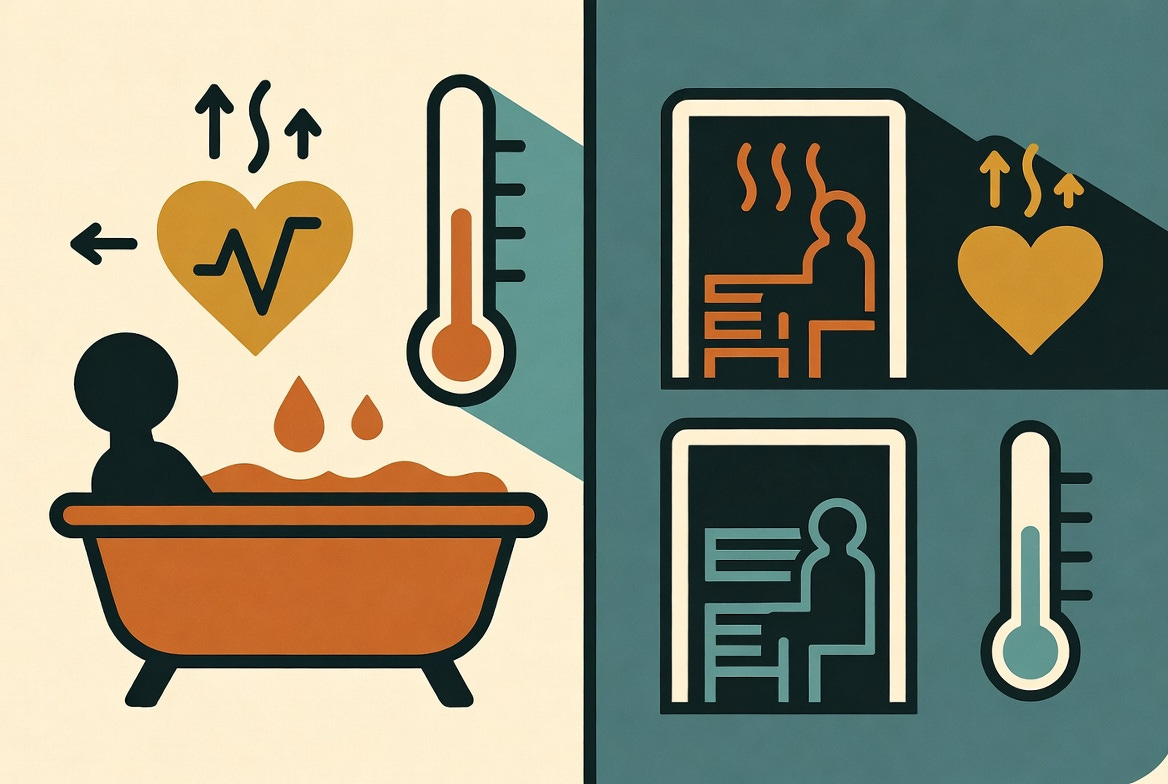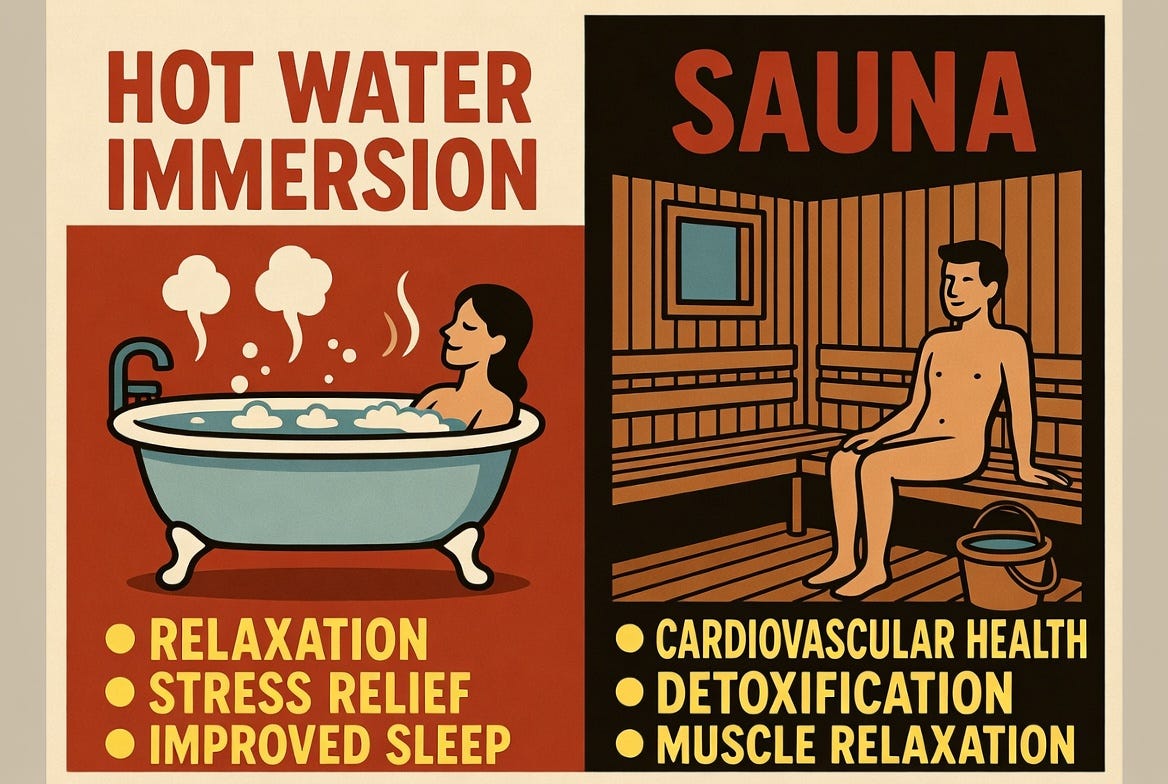Hot Tub vs Sauna Benefits: Why Your Tub Beats Saunas for Heart Health and Immunity
A head-to-head comparison reveals hot water immersion trumps traditional and far infrared saunas for raising core temperature, cardiac output, and immune response.
You’ve probably heard the buzz: saunas and hot baths are the new exercise. But do they actually work the same way? This research is a deep dive into three popular heat therapy methods—hot water immersion, traditional Finnish sauna, and far infrared sauna—to see which one packs the biggest physiological punch. Spoiler: your bathtub might be the MVP.
Hot water immersion raised core temperature by 1.1°C and boosted cardiac output by 3.7 L/min—nearly double the effects of traditional sauna and far surpassing far infrared.
What’s the Big Idea?
This study on passive heat therapy is a rare side-by-side comparison of how your body responds to different heating modalities. Twenty healthy adults (average age 24) cycled through three 45-minute sessions: soaking in a 40.5°C hot tub, sweating through a traditional sauna set to 80°C (measured at 66°C), and relaxing in a far infrared sauna ramped from 46°C to 65°C. Researchers tracked core temperature, heart rate, cardiac output, blood pressure, and immune markers—before, during, and up to 48 hours after each session.
The findings reveal stark differences. Hot water immersion drove core temperature up by 1.1°C, while traditional sauna managed just 0.4°C and far infrared barely budged at 0.0°C. Cardiac output—the volume of blood your heart pumps per minute—surged by 3.7 L/min in the tub, compared to 2.3 L/min in traditional sauna and a modest 1.6 L/min in far infrared. Only hot water immersion triggered a significant immune response, marked by elevated interleukin-6 (IL-6), a key inflammatory signal, and increases in natural killer (NK) cells and cytotoxic T cells at 24 and 48 hours post-soak.
Why does this matter? Heat therapy mimics moderate aerobic exercise—think increased heart rate, blood flow to the skin, and cardiovascular strain—without the joint impact or physical exertion. The challenge: not all heat is created equal. Water’s thermal conductivity is 24 times greater than air, meaning your body absorbs heat faster and struggles to cool off via sweat when submerged. That’s why the tub delivered the most robust thermoregulatory and cardiovascular responses. Meanwhile, traditional sauna’s intermittent protocol (3 × 10 minutes with 5-minute breaks) and far infrared’s lower sustained temperatures failed to match the thermal load.
Why It Matters (and What You Can Do)
This research is a nudge toward smarter heat therapy choices if you’re chasing cardiovascular or immune benefits. Hot water immersion isn’t just relaxing—it’s physiologically demanding. The 1.1°C core temperature spike triggered systemic vascular resistance to drop by 9.2 mmHg·min/L, forcing the heart to compensate with higher output. Blood pressure dipped by 14 mmHg during the soak, and heart rate climbed by 39 beats per minute. These changes mirror what happens during a moderate workout, suggesting repeated exposures could improve vascular function, reduce arterial stiffness, or lower resting blood pressure over time.
For immune health, the IL-6 bump post-immersion hints at an acute inflammatory response—similar to exercise—that may reduce chronic, low-grade inflammation with regular use. NK cells and CD8+ T cells, which play critical roles in fighting infections and surveilling for abnormal cells, were still elevated 24 to 48 hours later. That’s meaningful if you’re looking to bolster immunity without pounding the pavement.
Start with hot water immersion if you can tolerate it: aim for 40–41°C water for 45 minutes, staying immersed to your sternum. Hydrate before and during (participants drank ad libitum), and expect to feel warm, slightly uncomfortable, and fatigued—ratings of perceived exertion hit 13 out of 20, comparable to light jogging. Ease in gradually if you’re new to heat therapy; participants were passive-heating naive and found a 2 × 15-minute traditional sauna protocol too intense during pilot testing.
Traditional sauna works if you prefer dry heat, but consider longer continuous sessions (30+ minutes at 70–80°C) rather than short intervals to sustain core temperature gains. Far infrared saunas, at least in larger commercial units like the one tested here, underperformed—core temperature didn’t budge. Smaller Waon therapy cabins (15 minutes at uniform 60°C) may fare better, but evidence is limited.
What’s Next on the Horizon?
The research opens questions about dose and duration. How long do you need to soak, and how hot, to trigger meaningful adaptations? Can 20 minutes of hot water immersion elicit similar benefits to 45 minutes if the water’s hotter? And what about populations who need it most—older adults, people with cardiovascular disease, or those unable to exercise? Young, healthy participants tolerated hot water immersion well, but chronic inflammation and reduced thermotolerance in older individuals might amplify (or complicate) responses.
Future work should also explore chronic effects. One Finnish study linked frequent sauna use (4–7 times per week) to lower all-cause mortality and reduced systemic inflammation over decades. Could hot baths deliver similar long-term perks? Researchers hint that repeated heat exposure may lower C-reactive protein and improve insulin sensitivity, but controlled trials are scarce.
There’s also the practical angle: access. Not everyone can afford a sauna or has space for one, but a bathtub? That’s doable. Socioeconomic barriers matter when prescribing heat therapy as a public health tool. If hot water immersion proves equally—or more—effective than saunas, it democratizes the intervention.
Safety, Ethics, and Caveats
This research is promising, but context is key. Participants were young (24 ± 4 years), healthy, and recreationally active—about as low-risk as it gets. Hot water immersion was uncomfortable: thermal sensation scores hit 6.9 out of 7 (”hot”), and thermal comfort dropped to 3.1 out of 4 (”very uncomfortable”). If you’ve got cardiovascular issues, heat intolerance, or are pregnant, consult a physician before diving in. The study excluded anyone with chronic disease or on medications (except contraceptives), so we don’t know how these populations would respond.
Also, the sauna temperatures reported here were lower than advertised. The traditional sauna was set to 80°C but measured at 66°C; far infrared averaged 45°C versus the factory thermostat’s 57°C. That’s a real-world caveat—commercial units don’t always deliver what’s on the dial, which may explain why sauna effects were muted. Researchers recommend validating temperatures with research-grade sensors if you’re serious about replicating these conditions.
Finally, this was an acute study. A single hot bath won’t cure disease, and chronic inflammation likely requires repeated exposures to shift. The IL-6 increase here was temporary, not a sustained anti-inflammatory effect. Think of heat therapy as a long game, not a quick fix.
Explore the Full Study
Atencio, J.K., Reed, E.L., Needham, K.W., Lucernoni, K.M., Comrada, L.N., Halliwill, J.R., & Minson, C.T. (2025). Comparison of thermoregulatory, cardiovascular, and immune responses to different passive heat therapy modalities. American Journal of Physiology-Regulatory, Integrative and Comparative Physiology, 329, R20–R35. https://doi.org/10.1152/ajpregu.00012.2025



